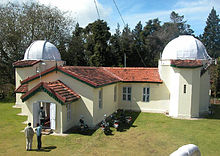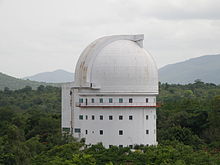Indian Institute of Astrophysics
The Indian Institute of Astrophysics is an astrophysical institute in India . The head office is in the Koramangala district in Bengaluru . An establishment of the Institute, the Center for Research and Education in Science and Technology (CREST), is located in Hosakote ( 14 ° 16 '47 " N , 77 ° 10' 48" O ). The institute is administered by the Department of Science and Technology of the State of India.
The origin of the institute can be traced back to a private observatory founded by William Petrie (d. 1816), an officer of the East India Company . He established the observatory in Egmore , Chennai (formerly Madras). This observatory was taken over by the East India Company in 1790 under the scientific leadership of astronomer Michael Topping. Shortly afterwards (1792) an expansion and relocation to Nungambakkam , Chennai took place. This created the first modern observatory outside of Europe.
Several astronomical observatories in India are supervised by the institute .
Kodaikanal Observatory
The Kodaikanal Observatory is located in the Palani Mountains in southern India. It was established as a solar physics observatory in 1899, and all Madras activities have been relocated there. The 20 cm refractor is still occasionally used today to observe comets and occultations , at other times it is open to visitors.
The observatory has an astronomy museum in which, among other things, a current image of the sun and the associated Fraunhofer spectrum are shown. It also has a library with historically valuable books.
Vainu Bappu Observatory
The Vainu Bappu Observatory, or “VBO” for short, is located in the Javadi Mountains at an altitude of 700 m near the village of Kavalur in the Indian state of Tamil Nadu , 175 km southeast of Bengaluru . It is named in honor of Vainu Bappu (1927–1982), President of the International Astronomical Union , who was committed to astronomy in India.
Instruments
The institute's largest telescope has been the Vainu-Bappu telescope since 1986, which is one of the largest telescopes in Asia. It is a reflector telescope with a primary mirror diameter of 2.34 m and a focal length of 7.6 m, the entire telescope has an effective focal length of 30.42 m. A number of instruments are available for the telescope:
- Image sensor with three-element Wynne corrector for the primary focus
- Spectropolarimeter , for the Cassegrain focus ,
- OMRS, a medium resolution spectrograph from Optometrics Research, also for the Cassegrain focus.
Other telescopes in the observatory are a 1 m Zeiss mirror telescope and a 0.75 m mirror telescope. The observatory also has a Fabry-Pérot interferometer .
research
An ongoing research goal is the observation of stars , star clusters , novae , supernovae , blazars , galaxies , the imaging of gamma-ray flashes , star populations , objects in the solar system and various others.
The 1 m telescope made two special discoveries in our solar system. In 1972 it was found that Jupiter's moon Ganymede had an atmosphere , and in 1977 rings were first observed on the planet Uranus .
On February 17, 1988, a planetoid was discovered with a 45 cm Schmidt telescope . It was named " 4130 Ramanujan " after the outstanding Indian mathematician S. Ramanujan . The Minor Planet Center has assigned the VBO the observatory code 220.
Many stars of the Large Magellanic Cloud could be spectroscoped with extremely low dispersion . Ten Novae were examined, as well as the Supernova 1987A .
Gauribidanur Observatory
The Gauribidanur Observatory has a number of radio astronomy instruments:
- Gauribandur Telescope (GEETEE), a telescope for observation in the decameter range. It consists of 1000 dipole antennas arranged in a T configuration. The east-west extension is 1.4 km, the southern arm is 0.5 km long.
- Gauribandur Radioheliograph (GRH), for two-dimensional imaging of the solar corona in the frequency range 40–150 MHz. It consists of 192 logarithmic-periodic dipoles, which are also in a T-arrangement.
- High Resolution Radio Spectrograph , it consists of 8 logarithmic-periodic dipoles and is used in conjunction with the GRH to record short-term events.
- Polarization interferometer , it consists of 32 logarithmic-periodic dipoles in four groups, rotated by 0 °, 45 °, 90 ° and 135 ° in relation to the north-south direction. It is used to study the sun's magnetic field.
In addition, it is involved in projects outside of India:
- Mauritius Radio Telescope (MRT) and
- Brazilian Decimeter Array (BDA)
Indian Astronomical Observatory
The Indian Astronomical Observatory is at an altitude of 4500 m and is one of the highest observatories in the world. It is located in Hanle , Changthang , Ladakh , north of the Western Himalayas . The high location and the low water content of the atmosphere due to the climate of the region allow excellent observation possibilities in the optical, infrared, submillimeter and millimeter range.
- Since 2001, the observatory has had a remotely controllable 2 m reflector telescope, the Himalayan Chandra Telescope (HCT), for observations in the visible and infrared spectral range. The telescope is controlled remotely by CREST via its own satellite connection.
- In cooperation with the University of Washington, there is a 0.5 m telescope on the site for continuous observation of active galaxy centers. The telescope is part of the Antipodal Transient Observatory , the second telescope is located in Sonoita, Arizona .
- a 0.3 m telescope for differential image motion observation
- a 220 GHz radiometer
- The HAGAR telescope for observing astronomical gamma radiation sources . The telescope consists of seven stations, each equipped with 7 mirrors. In total, there is a mirror area of 31 square meters for observations from 50 GeV .
Web links
- Homepage of the Indian Institute of Astrophysics with information about the observatories (English)
- History (English)
- Antipodal Transient Observatory (English) ( Memento from 1 July 2014 Internet Archive )
Coordinates: 12 ° 55 ′ 35 ″ N , 77 ° 37 ′ 16 ″ E



